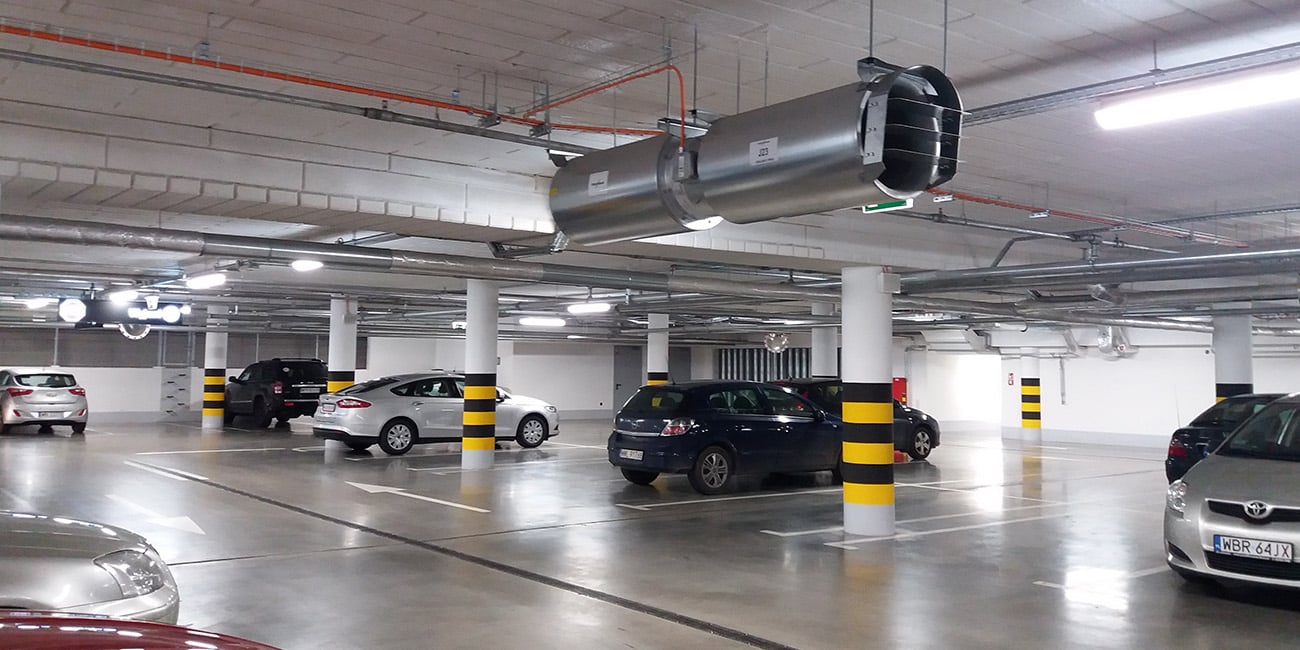Grease interceptors are essential components of restaurant MEP (mechanical, electrical, and plumbing) systems. They prevent fats, oils, and grease (FOG)

Despite the development of advanced gas and smoke detection devices for the garage, fire accidents can occur on a regular basis, destroying many cars in the process. However, the impact of these accidents can be reduced by creating a garage ventilation system design.
Specifically, a garage ventilation system will successfully extract the smoke from the garage facility if a fire breaks out. As a result, this will ensure a safe evacuation of occupants in the building by maintaining sufficient visibility or reducing the temperature, while making the job of the firefighters easier. More importantly, a garage ventilation system extracts toxic gasses like carbon monoxide from the facility and maintains the fresh-air supply, thus preventing the formation of ‘dead zones’, where toxic substances can accumulate.
Generally, the requirements for ventilation system design for garage facilities depend on various local standards. However, the system must always perform 2 key roles successfully. That is; get rid of the pollutants emitted by vehicles and control the gases and hot fumes produced in case of a fire accident. In addition, it should maintain convenient access for the fire rescue team and protect the escape routes for people in the facility.
In enclosed parking garages with poorly-maintained or inadequate ventilation systems, fumes emitted by vehicles exiting, entering, or driving through the building can accumulate to toxic levels. To prevent this from happening, ventilation systems in traditional parking garages combine exhaust and supply with ductwork to remove harmful emissions, smoke, and pollutants and push in the fresh air. To be precise, the major task for these ventilation systems is to exhaust toxic gases that may cause poor air quality like carbon monoxide, Sulphur oxides, and nitrogen oxides from an underground car park.
The concentration of Carbon Monoxide poses the biggest threat, even in low quantities, as it can cause harmful side effects and sometimes death. Moreover, CO has no color or odor, so it can quickly poison people in the garage before they even sense something is wrong.
According to the ASHRAE Handbook, emissions of CO (Carbon Monoxide) are one of the most serious problems presented by parking garages. As a result, ANSI/ ASHRAE Standard 62 (Ventilation for Acceptable IAQ) proposes an average ambient air quality of less than 9 ppm over 8 hours for enclosed parking garage facilities. In addition, other engineering institutions have set similar garage ventilation system design requirements, with 9 to 35 ppm maximum carbon monoxide concentration over an 8-hour exposure period and 100 to 200 ppm for short-term exposure.
However, regardless of the standards you follow and where your garage facility is located, maintaining air quality while meeting safety requirements is always a key challenge for MEP engineers specializing in parking garage ventilation system design.
Similarly, finding the optimal configuration, number, and location of the exhaust fans needed for garage ventilation, while ensuring that it meets the requirements of CO exposure limit can be challenging. Luckily, you can use Computational Fluid Dynamics (CFD) to simultaneously predict airflow, contaminant movement, and heat transfer inside the garage facility. This will play a crucial role in guiding HVAC design engineers toward the right decision when creating a ventilation system design for enclosed parking garages.
Natural ventilation may be sufficient to reduce the concentration of carbon monoxide in open and semi-open parking garages. However, for closed and underground parking garages, jet fans or channeled mechanical ventilation systems must be used to prevent excessive carbon monoxide concentration levels.
Jet fan ventilation systems are the most commonly used ventilation systems for CO removal in underground car parks. CFD modeling of the car park can be undertaken to simulate how jet fan placement can help to minimize the concentration of CO in the facility without requiring a complex duct system. In addition, CFD simulations can be used to examine the concentration and velocity of Carbon monoxide distribution in the parking garage with and without a jet fan ventilation system.
Without jet fans, the simulations will visualize the carbon monoxide concentration patterns, clearly revealing many large ‘dead zones’. In comparison, CFD simulations with jet fan placement will show that the ventilation system has eliminated the regions with CO concentration.
Final Word
Carbon monoxide is considered the most dangerous product of combustion. At a concentration of above 1% volume, CO can make you lose consciousness and die within 3 minutes. Moreover, carbon monoxide poisoning is one of the leading causes of death in fire accidents, making it necessary to create ventilation systems that get rid of this gas in enclosed facilities.
For underground and enclosed parking garages, incorporating jet fans into the facility’s ventilation system can reduce the maximum concentration of carbon monoxide by about 55%, while improving the overall air quality and air velocity throughout the garage. In addition, CFD simulation will play a key role in helping HVAC design engineers test any design ventilation design change with ease. Even better, this will allow HVAC engineers to virtually analyze the performance of a ventilation system and ensure there is adequate air movement to remove carbon monoxide in the parking garage.
To learn more about ventilation system design for parking garage facilities in California, contact InnoDez Design & Engineering today!
About Author
InnoDez